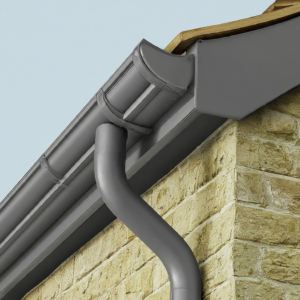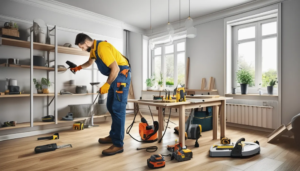
In the world of DIY home improvement, stenciling floors has emerged as a trendy and cost-effective way to transform spaces. With the right tools and techniques, you can add a touch of personalized style to any room. In this comprehensive guide, we’ll walk you through the latest tips and methods for painting your floor with stencils, ensuring a professional finish that will leave your friends and family in awe.
The Rise of Floor Stenciling
Floor stenciling has seen a surge in popularity due to its versatility and the endless design possibilities it offers. Whether you’re looking to mimic expensive tile patterns or create a unique, custom look, stenciling provides an affordable and relatively easy solution. This trend has been particularly popular on social media platforms like Pinterest and Instagram, where DIY enthusiasts showcase their stunning floor transformations.
Also Read: Painting Tile Floors & Avoid Peeling for a Long Time!

Tools and Materials You’ll Need
Before you dive into your stenciling project, gather the necessary tools and materials. Here’s a checklist to get you started:
- Stencil of your choice: Available in various designs and sizes.
- Base coat paint: Typically a latex or acrylic paint.
- Stencil paint: A durable paint suitable for floors.
- Paint rollers and brushes: For both the base coat and stencil application.
- Painter’s tape: To secure the stencil in place.
- Stencil adhesive spray: Helps keep the stencil flat against the floor.
- Sealant: A clear topcoat to protect your design.
- Measuring tape and level: Ensures your stencil is aligned correctly.
- Drop cloths and masking paper: To protect areas not being painted.
Preparing the Floor
Preparation is key to achieving a flawless finish. Follow these steps to prepare your floor for stenciling:
Cleaning the Surface
Start by thoroughly cleaning the floor to remove any dust, dirt, or debris. Use a mild detergent and water to scrub the surface, then rinse well and allow it to dry completely. For stubborn stains, consider using a floor cleaner or a degreaser.
Sanding and Repairing
If your floor has any imperfections, now is the time to address them. Sand any rough spots or uneven areas to create a smooth surface. Fill any cracks or holes with a suitable floor filler and sand again once dry. Wipe away any sanding dust with a damp cloth.
Applying the Base Coat
The base coat serves as the foundation for your stenciled design. Choose a high-quality paint that is appropriate for your floor type. Apply the base coat using a roller, working in small sections to ensure even coverage. Allow the paint to dry completely before moving on to the next step. Depending on the color and type of paint, you may need to apply a second coat.
Choosing and Positioning Your Stencil
Selecting the right stencil design is crucial for achieving your desired look. Consider the size of the room, the overall decor, and your personal style when making your choice. Popular designs include geometric patterns, floral motifs, and intricate tile replicas.
Measuring and Marking
To ensure your stencil is positioned correctly, measure and mark the starting point on your floor. Use a measuring tape and a level to draw light pencil lines where the stencil will be placed. This will help keep your design straight and aligned throughout the project.
Securing the Stencil
Once you have your starting point marked, secure the stencil to the floor using painter’s tape or stencil adhesive spray. Make sure the stencil lies flat against the floor to prevent paint from bleeding underneath.

Painting the Stencil
With your stencil in place, it’s time to start painting. Follow these steps for the best results:
Applying the Paint
Using a stencil brush or a small foam roller, apply the stencil paint in thin, even layers. It’s important to use a minimal amount of paint to avoid bleeding. Dab off any excess paint on a paper towel before applying it to the stencil. Gently press the brush or roller over the stencil, working from the edges inward.
Also Read: How Much Does A Handyman Charge To Paint A Room In Minnesota?
Removing the Stencil
Carefully lift the stencil away from the floor while the paint is still wet. This helps prevent smudging and allows you to clean the stencil if needed before reapplying it in the next position. If any paint has bled under the stencil, use a small brush to touch up the edges.
Repositioning the Stencil
Align the stencil with the previously painted section and secure it in place. Continue the pattern by repeating the painting and lifting process until the entire floor is covered. Make sure to clean the stencil periodically to avoid paint buildup that can affect the quality of the design.
Finishing Touches
After the stencil design is complete, allow the paint to dry thoroughly. Depending on the paint and the environmental conditions, this may take several hours to a full day.
Applying the Sealant
To protect your stenciled floor and ensure its longevity, apply a clear sealant. Choose a sealant that is suitable for your floor type and provides the desired finish, whether it’s matte, satin, or glossy. Apply the sealant in thin, even coats using a clean roller or brush. Allow each coat to dry completely before applying the next one. Typically, two to three coats are recommended for optimal protection.
Curing Time
After the final coat of sealant is applied, let the floor cure for the recommended time as specified by the manufacturer. This can range from a few days to a week. Avoid placing heavy furniture or rugs on the floor until it is fully cured to prevent damage to your new stenciled design.
Maintenance and Care
To keep your stenciled floor looking fresh and vibrant, follow these maintenance tips:
- Regular Cleaning: Sweep or vacuum the floor regularly to remove dirt and debris. Use a damp mop with a mild cleaner to maintain the finish.
- Avoid Harsh Chemicals: Refrain from using abrasive cleaners or harsh chemicals that can damage the paint and sealant.
- Protective Measures: Place felt pads under furniture legs to prevent scratches. Use rugs or mats in high-traffic areas to reduce wear and tear.
Popular Stencil Designs and Trends
As stenciling floors continues to gain popularity, certain designs and trends have emerged as favorites among DIY enthusiasts:
Geometric Patterns
Bold geometric patterns, such as hexagons, chevrons, and diamonds, add a modern and stylish touch to any room. These designs can create the illusion of expensive tile work and are perfect for kitchens, bathrooms, and entryways.
Vintage and Moroccan Tiles
For a timeless and exotic look, vintage and Moroccan tile designs are a top choice. These intricate patterns bring a touch of global flair and sophistication to your floors. Pair them with neutral or bold colors to match your decor.
Nature-Inspired Motifs
Floral and botanical stencils are ideal for adding a touch of nature to your home. From delicate leaf patterns to bold floral designs, these stencils can bring a fresh and calming atmosphere to any space.

Expert Tips and Tricks
To ensure your floor stenciling project is a success, consider these expert tips:
Test Your Design
Before committing to the entire floor, test your stencil design in a small, inconspicuous area. This allows you to make adjustments and perfect your technique without risking the entire project.
Patience is Key
Take your time and be patient throughout the stenciling process. Rushing can lead to mistakes and uneven results. Allow each layer of paint to dry completely before moving on to the next step.
Customization
Don’t be afraid to get creative and customize your stencil design. Mix and match different patterns, use multiple colors, or even create your own stencil for a truly unique look.
Conclusion
Stenciling your floor is a fantastic way to add personality and style to your home without breaking the bank. With careful planning, the right tools, and a bit of patience, you can achieve professional-looking results that will impress anyone who steps into your space. Whether you choose a bold geometric pattern, a vintage tile design, or a nature-inspired motif, your stenciled floor will undoubtedly become a focal point of your home.



